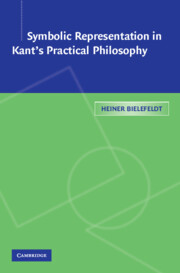Book contents
- Frontmatter
- Contents
- Citations and Translations
- Acknowledgments
- I INTRODUCTION
- II KANT'S SOCRATIC ENLIGHTENMENT
- III THE LAW OF FREEDOM
- IV HOW TO FIND ORIENTATION IN MORAL PRACTICE
- V THE ORDER OF RIGHTS AS A SYMBOL OF HUMAN DIGNITY
- VI TRACES OF PURPOSIVENESS IN NATURE AND HISTORY
- VII SYMBOLISM IN THE PHILOSOPHY OF RELIGION
- VIII CONCLUSION
- Bibliography
- Index
VIII - CONCLUSION
Published online by Cambridge University Press: 12 July 2009
- Frontmatter
- Contents
- Citations and Translations
- Acknowledgments
- I INTRODUCTION
- II KANT'S SOCRATIC ENLIGHTENMENT
- III THE LAW OF FREEDOM
- IV HOW TO FIND ORIENTATION IN MORAL PRACTICE
- V THE ORDER OF RIGHTS AS A SYMBOL OF HUMAN DIGNITY
- VI TRACES OF PURPOSIVENESS IN NATURE AND HISTORY
- VII SYMBOLISM IN THE PHILOSOPHY OF RELIGION
- VIII CONCLUSION
- Bibliography
- Index
Summary
Ways of Symbolic Representation
In the various chapters of this book, we have seen that symbolic representation occurs throughout Kant's practical philosophy, in his moral and legal philosophy as well as in his philosophy of history or religion. The symbols that we have come across, however, show very different features: Whereas some symbols are strict, others have a more playful character. We find highly abstract analogies, such as the natural law (providing the “type of the moral law”), alongside the colorful metaphors, for instance, of popular religion. Some symbols may be interchangeable; others may be not. While in some cases, the symbolic dimension comes explicitly to the fore, in other cases the symbolic aspect remains implicit. Symbolic meaning occurs not only in language, but also in societal institutions (such as the state or the church), which are supposed to epitomize normative or religious ideas. In addition, it seems that symbolic representation serves different purposes in Kant's practical philosophy: It offers guidelines for moral judgment and enhances the awareness of our moral vocation; it can improve our understanding of the normative role of societal institutions as well as strengthen our hope that moral commitment actually makes a difference in the world.
Given the manifold ways in which symbolic representation proceeds, as well as the various purposes it serves, it certainly seems desirable to bring some order to the realm of symbols.
- Type
- Chapter
- Information
- Symbolic Representation in Kant's Practical Philosophy , pp. 179 - 188Publisher: Cambridge University PressPrint publication year: 2003



